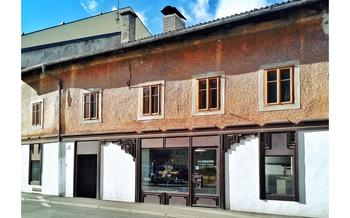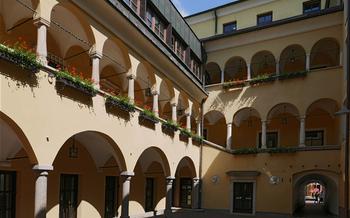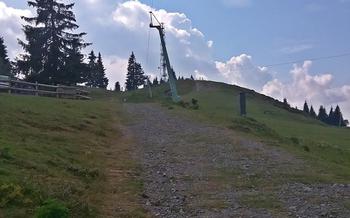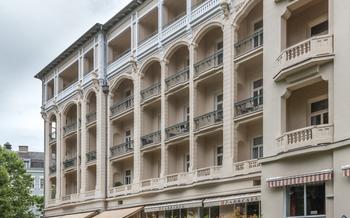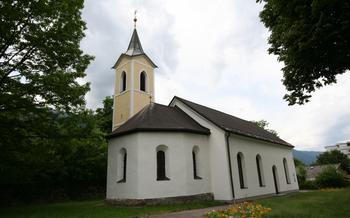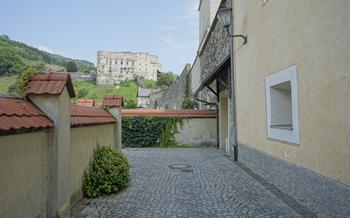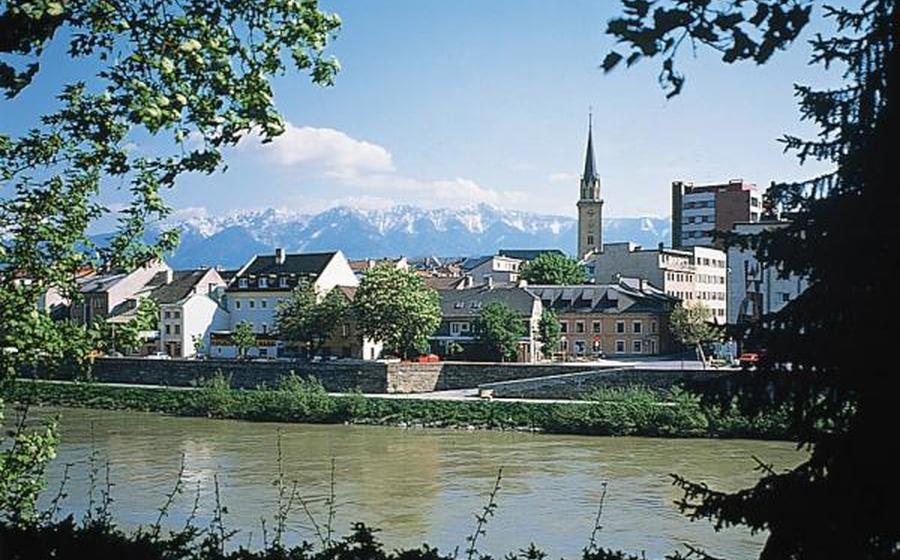
Gailtal Railway Museum
- Villach: A Railway Hub of the Past
- Gailtal Railway Museum: A Hidden Gem
- Location and Accessibility
- Museum Exhibits and Collections
- History of the Gailtal Railway
- Preservation Efforts and Restoration
- Guided Tours and Demonstrations
- Model Railway Exhibit: A Miniature Masterpiece
- Educational Programs and Workshops
- Museum Shop and Souvenirs
- Visitor Information and Facilities
- Nearby Attractions and Activities
- Photography Opportunities
- Personal Experience and Anecdotes
- Insider Tip:
Villach: A Railway Hub of the Past
Villach, nestled in the picturesque Gail Valley of Austria, boasts a rich railway heritage that dates back to the 19th century. The city's strategic location at the crossroads of important trade routes made it a crucial railway hub, connecting the Austro-Hungarian Empire to the Adriatic coast and beyond. The Südbahn (Southern Railway) line, constructed in the mid-1800s, played a pivotal role in this development, linking Villach to major cities like Vienna and Trieste. Another significant railway line, the Gailtal Railway, was built in the late 19th century to connect Villach to the Gail Valley, opening up new possibilities for trade and tourism in the region. These railways transformed Villach into a bustling railway center, contributing to its economic growth and prosperity.
Gailtal Railway Museum: A Hidden Gem
Nestled in the heart of Villach, the Gailtal Railway Museum stands as a testament to the city's rich railway heritage. This hidden gem is a haven for railway enthusiasts and history buffs alike, offering an immersive journey into the past of the Gailtal Railway, a crucial transportation artery that once connected Villach to the Gail Valley. The museum's collection of historic locomotives, carriages, and railway equipment provides a tangible link to a bygone era, inviting visitors to explore the fascinating world of rail transport.
Established in 1976, the Gailtal Railway Museum is a labor of love by a group of passionate volunteers dedicated to preserving the legacy of this iconic railway. Their tireless efforts have resulted in a comprehensive collection that showcases the evolution of railway technology and its impact on the development of the region. Visitors can marvel at meticulously restored locomotives, including the iconic steam locomotive 37203, which once hauled heavy freight trains along the Gailtal Railway.
The museum's collection also includes a diverse array of passenger carriages, ranging from elegant first-class compartments to humble third-class carriages. These carriages offer a glimpse into the social and economic disparities of the past, as well as the changing travel habits and preferences of passengers over the decades.
Location and Accessibility
The Gailtal Railway Museum is conveniently situated at Bahnhofstraße 25, 9500 Villach, Austria, making it easily accessible for visitors. The museum is located within walking distance from the Villach Hauptbahnhof (main train station), providing a seamless connection for those arriving by train. For those traveling by car, ample parking is available nearby, ensuring a hassle-free visit.
Combining a visit to the Gailtal Railway Museum with other attractions in Villach is a breeze. The museum is surrounded by a wealth of cultural and historical landmarks, making it an ideal starting point for exploring the city. Within a short distance, visitors can discover the Villach Cathedral, the Villach City Museum, and the Drau Cycle Path, offering a diverse range of experiences for every traveler.
Museum Exhibits and Collections
The Gailtal Railway Museum boasts a fascinating collection of historic locomotives, carriages, and railway equipment, taking visitors on a journey through the past. Among the highlights is the impressive steam locomotive 91361, a powerful workhorse that once hauled trains along the Gailtal Railway. The museum also showcases carriages from different eras, including a luxurious first-class carriage from the early 20th century and a more modest third-class carriage that transported ordinary passengers. Visitors can marvel at the intricate details and craftsmanship of these historic vehicles, which have been meticulously restored to their former glory.
Interactive exhibits and displays further enhance the visitor experience at the Gailtal Railway Museum. A model railway layout brings the history of the railway to life, with miniature trains chugging along a meticulously crafted landscape. Visitors can also learn about railway signaling systems, track maintenance, and the challenges faced by railway workers through interactive displays and educational panels. These engaging exhibits make the museum a great destination for visitors of all ages, allowing them to explore the world of railways in a fun and interactive way.
History of the Gailtal Railway
The Gailtal Railway, a vital transportation artery in the Gail Valley, traces its roots back to the mid-19th century. In 1858, the first section of the railway was constructed, connecting Villach to St. Stefan an der Gail. This initial stretch laid the foundation for the eventual expansion of the line throughout the valley.
The railway's construction faced numerous challenges, including the rugged terrain and the need to cross several rivers and gorges. However, the determination of engineers and the support of local communities ensured its steady progress. By 1869, the railway had reached Kötschach-Mauthen, marking the completion of the entire Gailtal line.
The Gailtal Railway played a pivotal role in the development of the region. It facilitated the transportation of goods and people, connecting remote villages to urban centers and opening up the valley to tourism. The railway also served as a catalyst for economic growth, stimulating trade and industry along its route.
During World War I, the Gailtal Railway suffered significant damage due to its strategic importance. However, after the war, it was rebuilt and continued to operate, becoming an integral part of the region's transportation network.
As the transportation landscape evolved and road networks improved, the Gailtal Railway faced declining passenger numbers. In 1969, the decision was made to close the line, marking the end of an era.
Despite its closure, the Gailtal Railway remains a symbol of the region's rich history and its enduring connection to the railway. The Gailtal Railway Museum, established in Villach, serves as a testament to the railway's legacy, preserving its locomotives, carriages, and infrastructure for future generations to appreciate.
Preservation Efforts and Restoration
The Gailtal Railway Museum plays a crucial role in preserving and restoring the Gailtal Railway's historic rolling stock and infrastructure. A dedicated team of experts works tirelessly to maintain and restore the museum's collection of locomotives, carriages, and railway equipment to their former glory. Visitors can witness the painstaking process of restoration as they explore the museum's workshops, where skilled craftsmen use traditional techniques to bring these historic machines back to life.
The preservation efforts at the Gailtal Railway Museum face several challenges. One of the biggest hurdles is the scarcity of original parts and materials. To overcome this, the museum works closely with specialist suppliers and enthusiasts to source authentic replacements or fabricate custom parts using traditional methods. Another challenge lies in the limited resources available for restoration projects. The museum relies on donations, grants, and fundraising initiatives to support its ongoing preservation work.
Despite these challenges, the Gailtal Railway Museum has made significant strides in restoring its collection. Several locomotives, carriages, and wagons have been meticulously restored to their original condition, allowing visitors to experience the railway's rich history firsthand. The museum's dedication to preserving the Gailtal Railway's heritage ensures that future generations can appreciate the technological advancements and engineering marvels that shaped this iconic railway.
Guided Tours and Demonstrations
The Gailtal Railway Museum offers guided tours that provide visitors with an in-depth look into the history and operation of the railway. Knowledgeable guides lead these tours, sharing fascinating stories and insights about the locomotives, carriages, and the challenges faced by the railway throughout its existence. Visitors can learn about the engineering marvels that made the Gailtal Railway possible, as well as the role it played in the development of the region.
In addition to guided tours, the museum also hosts special demonstrations and events that bring the railway's history to life. Visitors can witness restored locomotives in action, taking a ride on a historic train or participating in hands-on workshops. These demonstrations provide a unique opportunity to experience the sights, sounds, and smells of a bygone era, making the museum a truly immersive and interactive experience.
Whether you're a railway enthusiast, a history buff, or simply looking for a fun and educational day out, the guided tours and demonstrations at the Gailtal Railway Museum are sure to captivate and entertain visitors of all ages.
Model Railway Exhibit: A Miniature Masterpiece
The Gailtal Railway Museum boasts a captivating model railway exhibit that transports visitors to a world of miniature trains and landscapes. Intricately crafted layouts depict scenes from the Gail Valley, complete with tiny villages, rolling hills, and meticulously detailed railway tracks. Model trains chug along the tracks, creating a mesmerizing spectacle that brings the history of the Gailtal Railway to life.
The exhibit features a variety of scales and gauges, allowing visitors to appreciate the diversity and artistry of model railroading. From HO scale models to larger G scale trains, each layout showcases the skill and dedication of the museum's model railway enthusiasts. Visitors can marvel at the attention to detail in the miniature landscapes, which include realistic buildings, bridges, and vegetation.
The model railway exhibit is not just a passive display; it offers an interactive and educational experience for visitors of all ages. Interactive buttons and levers allow visitors to control the trains and activate various features of the layouts, such as lights, sound effects, and moving parts. This hands-on experience makes learning about railway operations and history both fun and engaging.
The Gailtal Railway Museum's model railway exhibit is a must-see for anyone interested in trains, miniatures, or the history of transportation. It provides a unique and immersive way to explore the world of railways and gain a deeper appreciation for the craftsmanship and engineering that went into the construction of these iconic machines.
Educational Programs and Workshops
The Gailtal Railway Museum offers a range of educational programs and workshops designed to engage and inspire visitors of all ages. These programs provide hands-on experiences and interactive learning opportunities that delve into the fascinating world of railways.
For families and children, the museum organizes workshops where they can build their own model trains, learn about railway engineering, and participate in fun activities related to the history and operation of trains. These workshops foster creativity, problem-solving skills, and a deeper appreciation for the intricate workings of railways.
School groups can benefit from guided tours tailored to their curriculum, allowing students to explore the museum's exhibits and learn about the significance of railways in shaping the region's history and economy. The museum's knowledgeable staff provides insights into the challenges faced by railway engineers and the innovations that transformed transportation.
The museum also hosts special events and workshops throughout the year, such as model railway exhibitions, lectures by railway experts, and demonstrations of railway equipment. These events offer a unique opportunity for enthusiasts to deepen their knowledge and connect with fellow railway buffs.
By participating in these educational programs and workshops, visitors gain a deeper understanding of the Gailtal Railway's history, the importance of railway transportation, and the enduring legacy of this iconic mode of travel.
Museum Shop and Souvenirs
The Gailtal Railway Museum boasts a well-stocked museum shop that offers a diverse selection of souvenirs and railway-related items. Visitors can browse through a range of unique and memorable items, including model trains, books, and railway memorabilia. The shop provides an excellent opportunity to take home a piece of the museum's history and share the experience with friends and family.
The museum shop is conveniently located within the museum premises, allowing visitors to easily access it after exploring the exhibits. The friendly and knowledgeable staff is always ready to assist visitors in selecting the perfect souvenir or gift. Proceeds from the museum shop directly contribute to the preservation efforts and support the museum's ongoing operations, ensuring that future generations can continue to enjoy and learn from this remarkable collection.
Visitor Information and Facilities
Practical Information
The Gailtal Railway Museum welcomes visitors with open arms. It operates from Tuesday to Sunday, from 10 am to 5 pm. During the summer months of July and August, its doors remain open until 6 pm. Visitors can purchase tickets on-site, and group discounts are available for parties of 10 or more. For inquiries and reservations, you can reach the museum via phone or email.
Facilities for a Comfortable Visit
The museum's facilities ensure a comfortable and enriching experience for all visitors. Clean and accessible restrooms are available on the premises, ensuring your convenience. If you need to refuel, the museum's café offers a delightful selection of snacks, beverages, and light meals. You can relax and savor your refreshments while immersing yourself in the museum's ambiance.
Accessibility for All
The Gailtal Railway Museum prioritizes accessibility for visitors with disabilities or special needs. The museum's layout allows for easy navigation, and wheelchair users can comfortably explore the exhibits. If you require any assistance or have specific requests, the friendly museum staff is always ready to help.
Nearby Attractions and Activities
The Gailtal Railway Museum is conveniently located near several other attractions and activities that visitors can combine for a fulfilling day trip or weekend getaway in the Villach region.
Just a short walk from the museum, visitors can explore the beautiful Villach Old Town, with its charming streets, historic buildings, and inviting cafes. The Villach Hauptplatz, the main square of the city, is a popular gathering spot and hosts various events throughout the year.
For those interested in history and culture, the Villach City Museum offers insights into the city's rich past, while the Kärnten Museum of Modern Art showcases a diverse collection of contemporary art.
Nature enthusiasts can take advantage of the nearby Drau River, which offers opportunities for swimming, kayaking, and fishing. The surrounding mountains provide scenic hiking trails and breathtaking views of the region.
Villach is also a great base for exploring the Gail Valley, known for its picturesque landscapes, traditional villages, and outdoor activities. Visitors can embark on a scenic train ride on the Gailtalbahn, which offers a unique perspective of the valley and its surroundings.
With its central location and proximity to numerous attractions, the Gailtal Railway Museum serves as an excellent starting point for discovering the cultural, historical, and natural wonders of the Villach region.
Photography Opportunities
The Gailtal Railway Museum is a treasure trove for railway enthusiasts and photographers alike. The historic locomotives, carriages, and railway infrastructure provide a picturesque backdrop for capturing stunning photographs. The museum's outdoor exhibits, with their backdrop of the Gail Valley, offer panoramic views that are perfect for capturing the grandeur of the railway's heritage.
Inside the museum, the meticulously restored locomotives and carriages provide ample opportunities for close-up photography. The intricate details of the engines, the plush interiors of the carriages, and the patina of time all make for compelling subjects. The museum's lighting is designed to enhance the visual appeal of the exhibits, creating a perfect environment for photographers to capture the essence of the railway's history.
When visiting the museum, be sure to take advantage of the natural light during the golden hours of sunrise and sunset. The warm hues of the morning and evening light cast a magical glow on the locomotives and carriages, creating a picturesque scene. Tripods are allowed inside the museum, enabling photographers to capture steady shots and experiment with different shutter speeds and apertures.
The museum staff is friendly and accommodating, and they are happy to provide assistance or advice to photographers. They can suggest the best spots for capturing specific angles or compositions and can provide information on any restrictions or guidelines regarding photography.
Whether you're a professional photographer or simply an enthusiast with a passion for capturing the beauty of history, the Gailtal Railway Museum offers a wealth of opportunities for creating stunning photographs. Don't forget to bring your camera and capture the essence of this unique railway heritage.
Personal Experience and Anecdotes
My visit to the Gailtal Railway Museum was a nostalgic journey through time, where the echoes of the past still reverberated within the preserved locomotives and carriages. As I stepped into the museum, I was immediately captivated by the sheer size and grandeur of the historic steam engines. The intricate details, gleaming brasswork, and the faint scent of oil and coal transported me back to an era when railways were not just a mode of transportation but a symbol of industrial prowess and ingenuity.
One particular exhibit that caught my attention was a beautifully restored carriage from the early 1900s. Its plush velvet seats, ornate woodwork, and gleaming brass fittings hinted at the elegance and opulence of rail travel in a bygone era. I imagined the stories these carriages could tell, of journeys undertaken by aristocrats, merchants, and ordinary people alike, connecting lives and destinies across the vast Austro-Hungarian Empire.
During my visit, I had the opportunity to witness a live demonstration of a restored steam locomotive. The rhythmic chugging of the engine, the billowing steam, and the shrill whistle filled the air, creating a sensory experience that transported me back to the golden age of rail travel. Watching the locomotive maneuver along the tracks, I couldn't help but marvel at the engineering prowess of those who designed and built these magnificent machines.
The Gailtal Railway Museum is not just a repository of historic artifacts; it's a place where the spirit of the past comes alive. Through its meticulously preserved exhibits, interactive displays, and passionate staff, the museum offers a unique and immersive experience that allows visitors to connect with the rich railway heritage of Villach and the Gail Valley.
Insider Tip:
For a truly unique and immersive experience, plan your visit to the Gailtal Railway Museum on one of the special event days when the museum operates historic steam locomotives. These special events take place throughout the year and offer visitors the chance to witness the powerful engines in action as they pull restored carriages along the museum's tracks. Experience the thrill of a train ride on one of these vintage locomotives, and step back in time as you journey through the beautiful Gail Valley. Be sure to check the museum's website or contact them in advance to confirm the dates of these special events and to ensure you don't miss this unforgettable experience.
